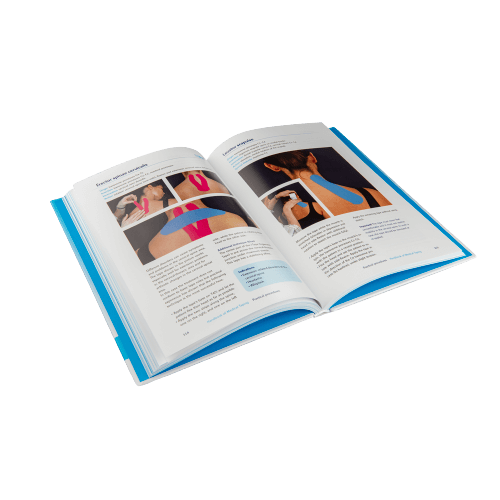Below, we describe a treatment option with both CureTape® and an application with CrossLinq. The treatment does not guarantee that the noise will disappear or diminish, but it is worth the effort.
Get started with these items to tape for tinnitus
-
CureTape® Classic Kinesiology Tape
Bestseller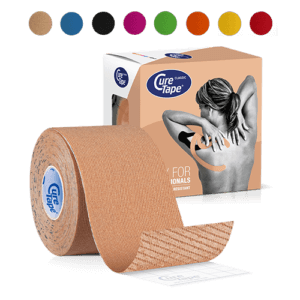 $19.95
In stockSelect options This product has multiple variants. The options may be chosen on the product page
$19.95
In stockSelect options This product has multiple variants. The options may be chosen on the product page -
CrossLinq® acupressure cross patches – Medium
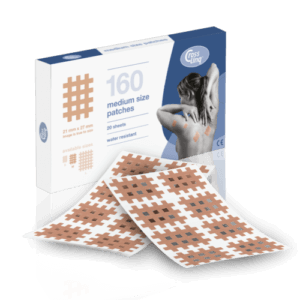 $24.50
In stockAdd to cart
$24.50
In stockAdd to cart -
CureTape® Classic 2.5cm Kinesiology Tape
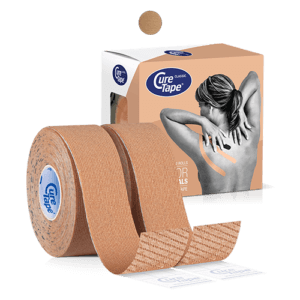 $21.95
In stockAdd to cart
$21.95
In stockAdd to cart -
Standard scissors
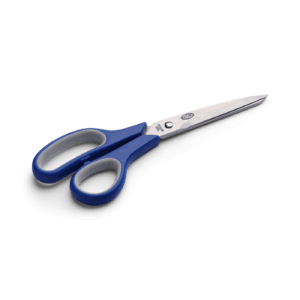 $14.95
In stockAdd to cart
$14.95
In stockAdd to cart
How to Tape Tinnitus with CureTape® kinesiology tape
The sternocleidomastoid muscle is an important muscle that can affect tinnitus. This muscle stabilises the head. The area where this muscle runs is very sensitive as nerves and blood vessels run under its surface. By taping this muscle, it is possible to influence tinnitus. The method has not been scientifically proven, but experienced tapers indicate that it can alleviate symptoms in some clients.
The professional therapist can determine whether this application could be applied to a client.
Because of the sensitivity, you should not use a stretch when applying the tape and you should remove the tape carefully in case of irritation.
- Cut a Y-tape from a strip 2.5 cm wide and measure the length of the tape in the stretched position of the muscle.
- Apply the tape without stretching, while the muscle is in a stretched position, starting from the mastoid process and the lateral part of the superior nuchal line, extending towards the sternum (manubrium sterni) and the end of the clavicle (sternal extremity of the clavicle).
This taping application can also be used for other indications such as torticollis, thoracic outlet syndrome (TOS) and headaches.

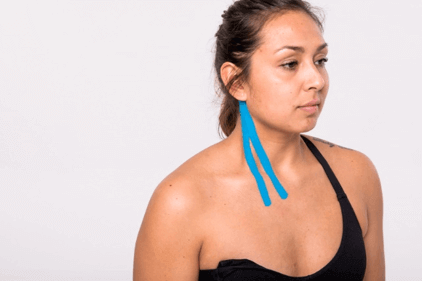
How to treat Tinnitus with CrossLinq acupressure cross patches
CrossLinqs are non-elastic synthetic grid plasters that can be widely used within a therapeutic treatment. Although the effect of CrossLinqs has not yet been scientifically proven, it has been empirically established that they work very well on:
- Pain points and trigger points.
- Influencing meridians.
- Muscle tone.
- Joint pain (post-operative, arthrosis, overload).
- Headaches/migraines.
- Tinnitus (ringing in the ears).
- Problems with the spinal column.
- Bruises.
- Trigger points.
- Pain management of phybromyalgia patients.
- Scars.
- Activation of lymphatic stations.
How does CrossLinq work?
Injuries, pain points and trigger points have a disruptive effect on the body and can cause tissue tension that results in potential differences in skin areas. These areas are strongly “energetically charged”. When removing the CrossLinq from the release paper, the CrossLinq becomes electrostatically charged. The therapist slowly moves the CrossLinq over the affected skin area and where a potential difference is present, the CrossLinq is automatically pulled towards it. At this point the grid plaster is applied. The potential difference in the treated area is eliminated because the self-healing capacity of the body is activated. The accompanying instruction video shows a CrossLinq treatment option for Tinnitus. This method has not been scientifically proven, but professionals indicate that they use this option in practice. Given the complexity of tinnitus, the treatment is not always successful, but for many it is worth a try. This application can of course also be combined with CureTape®.
Learn how to tape
- The Ultimate Taping Guide: Focuses on self-taping for the 30 most common injuries where taping provides support.
- Kinesiology Taping Method Manual: Designed for (para medical) professionals, covering basic taping techniques and various pathologies.
- Decompressive Taping Techniques Manual: Specifically focuses on lymphatic taping methods for decompression.
What are you waiting for? Order a copy today!
THYSOL is the manufacturer of the kinesiology tape brand CureTape. As CureTape, we have been training and supplying professionals for 25 years. And consumers now know how to find us too! By manufacturing all our tapes in our own factory, we can guarantee the best quality!
Please note that the indicated tape applications and information on our website about the possibilities with kinesiology tape have not yet been scientifically proven. The statements and examples mentioned are based on long-term experiences of patients and trained therapists.
Contraindications not to tape: pregnancy, open wounds, broken bones, unexplained complaints, allergies and skin diseases, use of medication such as blood thinners, thrombosis and fever. Always apply tape in consultation with a specialist.

